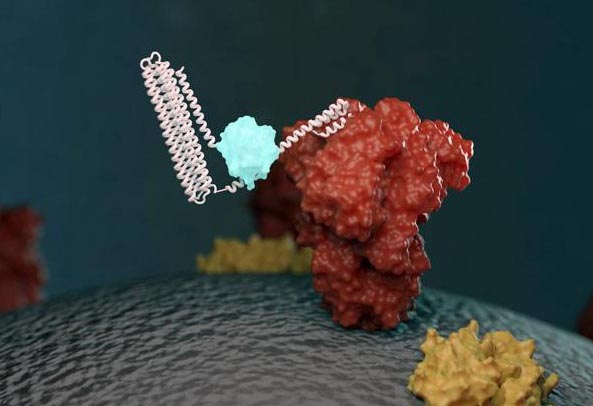Nikhil Prasad Fact checked by:Thailand Medical News Aug 19, 2024 8 months, 1 day, 4 hours, 57 minutes ago
COVID-19 News: Understanding the Role of CD81 in SARS-CoV-2 Spike Protein Trafficking
In a groundbreaking study conducted by researchers from the University of North Carolina, a novel approach was explored to enhance the understanding and application of SARS-CoV-2 Spike (S) protein trafficking. The study highlights the fusion of the S protein with the tetraspanin protein CD81, revealing significant alterations in the protein's maturation and trafficking pathways.
 CD81 fusion protein enhances SARS-CoV-2 spike trafficking and immune response
CD81 fusion protein enhances SARS-CoV-2 spike trafficking and immune response
This
COVID-19 News report delves into the study's key findings and the potential implications for future vaccine development and virus biology. The research team's innovative approach opens new avenues for the design of viral glycoprotein vaccines, aiming to improve the immune response and stability of these crucial proteins.
The Significance of SARS-CoV-2 Spike Protein
The SARS-CoV-2 virus, responsible for the COVID-19 pandemic, uses its Spike protein to enter human cells. This protein binds to the ACE2 receptor on the surface of human cells, facilitating viral entry and subsequent infection. The Spike protein's structure and function have been central to vaccine development efforts, as it is the primary target for neutralizing antibodies.
However, the stability and correct folding of the Spike protein are critical for its effectiveness in vaccines. Traditional vaccines rely on the expression of the Spike protein in isolation, which can lead to degradation and loss of efficacy. This challenge has driven researchers to explore new methods to enhance the stability and immune response of the Spike protein.
CD81 Fusion: A Novel Approach to Spike Protein Maturation
In their study, the research team explored the fusion of the SARS-CoV-2 Spike protein with CD81, a tetraspanin protein involved in the formation of extracellular vesicles (EVs). EVs are small, membrane-bound particles that play a crucial role in cell-to-cell communication. By fusing the Spike protein with CD81, the researchers aimed to redirect its maturation pathway, leading to enhanced stability and proper folding.
The CD81 - S-fusion protein was observed to avoid lysosomal degradation, a common fate for the Spike protein when expressed alone. Instead, the fusion protein was extruded into EVs, which are naturally produced in large numbers by cells and can be isolated to high purity. This novel approach allowed the Spike protein to be displayed on the surface of EVs in a trimeric form, mimicking its natural state on the virus.
Key Findings and Implications
The study's key findings highlight the potential of the CD81 - S-fusion protein in enhancing the stability and immune response of the Spike protein. The fusion protein displayed on EVs was able to bind to the ACE2 receptor, indicating that it maintained its correct trimeric structure. This binding is crucial for the protein's function in elici
ting an immune response.
Furthermore, the CD81 - S-fusion EVs were found to be non-toxic and capable of inducing a robust anti-S trimer and anti-receptor-binding domain (RBD) antibody response in mice. This response is a promising indicator of the fusion protein's potential as a vaccine candidate, as it suggests that the protein can effectively stimulate the immune system to recognize and neutralize the virus.
Enhancing Vaccine Design and Pandemic Preparedness
The implications of this study extend beyond the immediate findings. The CD81 - S-fusion approach offers a new design path for viral glycoprotein vaccines, potentially improving their stability, efficacy, and immune response. This is particularly important in the context of rapidly evolving viruses like SARS-CoV-2, where new variants may evade immunity generated by previous vaccines.
By enhancing the maturation and stability of the Spike protein, this approach could lead to more effective vaccines that provide longer-lasting immunity and better protection against diverse viral strains. Additionally, the use of EVs as a delivery platform for the Spike protein opens new avenues for vaccine development, leveraging the natural properties of these vesicles to enhance immune responses.
Conclusions and Future Directions
The study findings marks a significant advancement in our understanding of SARS-CoV-2 Spike protein trafficking and its potential applications in vaccine development. By fusing the Spike protein with CD81, the researchers successfully altered its maturation pathway, leading to enhanced stability and immune response.
As the scientific community continues to explore innovative solutions to combat viral threats, the CD81 - S-fusion protein represents a valuable tool in the ongoing battle against COVID-19 and other emerging infectious diseases. Future research will likely focus on optimizing this approach and exploring its potential in other viral contexts, further enhancing our preparedness for future pandemics.
This novel approach offers a promising design path for future viral glycoprotein vaccines, particularly in the face of rapidly evolving viruses.
The study findings were published in the peer-reviewed journal: mBio.
https://journals.asm.org/doi/10.1128/mbio.01922-24
For the latest
COVID-19 News, keep on logging to Thailand Medical News.
Read Also:
https://www.thailandmedical.news/news/sars-cov-2-reactivates-latent-hiv-and-can-influence-hiv-disease-progression
https://www.thailandmedical.news/news/study-shockingly-finds-that-those-who-develop-anosmia-during-covid-19-actually-end-up-with-brain-changes
https://www.thailandmedical.news/news/florida-study-finds-that-alzheimer-patients-who-contract-covid-19-end-up-with-worsened-brain-conditions
